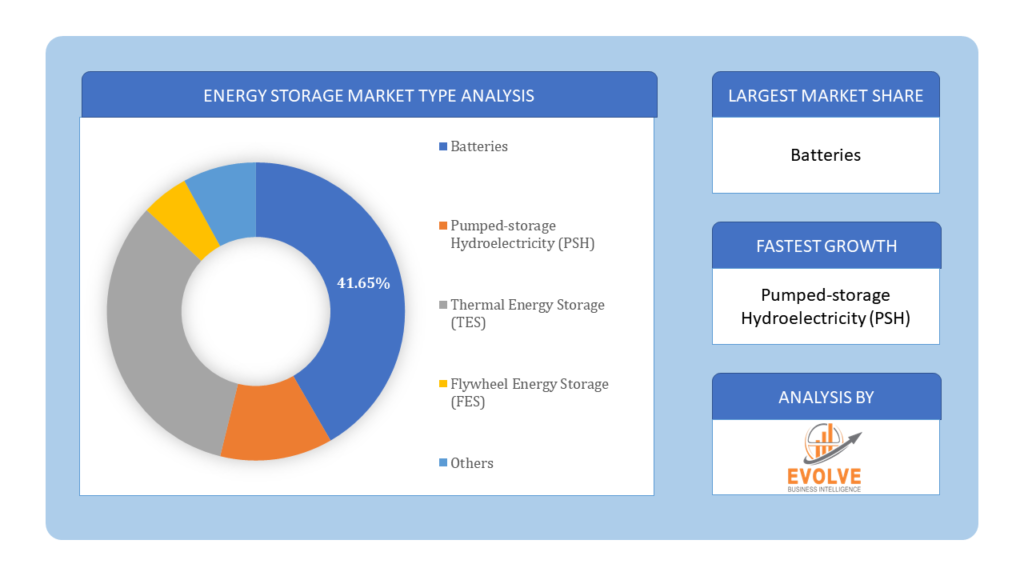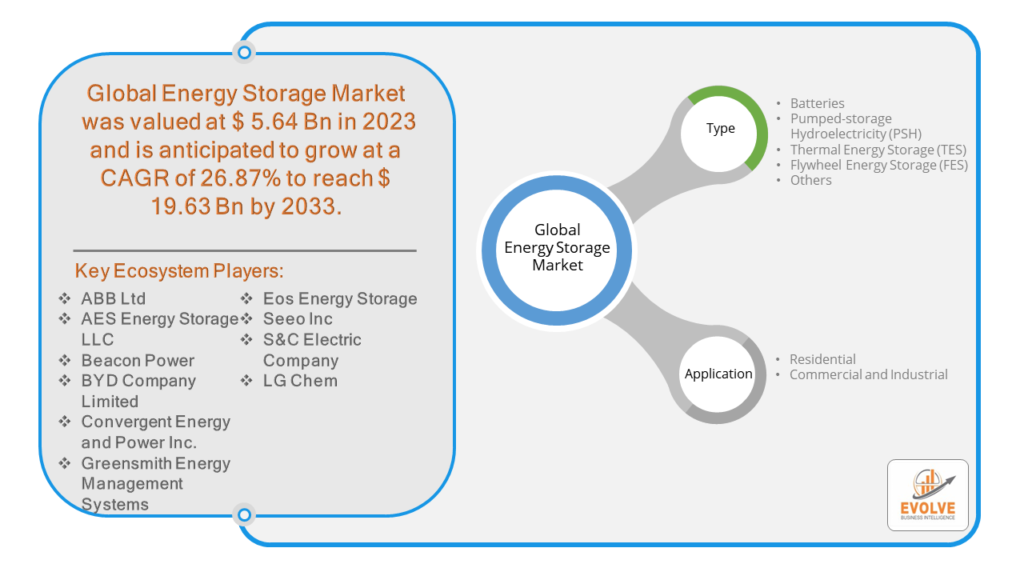Energy Storage Market Analysis and Global Forecast 2023-2033
$ 1,390.00 – $ 5,520.00Price range: $ 1,390.00 through $ 5,520.00
Energy Storage Market Research Report: Information By Type (Batteries, Pumped-storage Hydroelectricity (PSH), Thermal Energy Storage (TES), Flywheel Energy Storage (FES), Others), By Application (Residential, Commercial and Industrial), and by Region — Forecast till 2033
Page: 162
Energy Storage Market Overview
The Energy Storage Market Size is expected to reach USD 19.63 Billion by 2033. The Energy Storage Market industry size accounted for USD 5.64 Billion in 2023 and is expected to expand at a compound annual growth rate (CAGR) of 26.87% from 2023 to 2033. The Energy Storage Market encompasses the various technologies and systems used to store energy for later use. This market is crucial for balancing supply and demand, especially with the increasing adoption of renewable energy sources like wind and solar power, which are intermittent in nature.
The market is driven by the need for grid stability, energy efficiency, and the integration of renewable energy sources. It includes a wide range of applications from residential and commercial to utility-scale storage solutions. Key players in the market include companies that manufacture storage technologies, provide integration services, and develop innovative solutions to enhance storage capacity and efficiency.
Global Energy Storage Market Synopsis
The COVID-19 pandemic had a significant impact on the Energy Storage Market. The pandemic caused interruptions in the global supply chain, affecting the production and delivery of essential components for energy storage systems. Delays in manufacturing and shipping of batteries and other storage technologies were common. Many energy storage projects faced delays or cancellations due to restrictions on movement, reduced workforce availability, and financial constraints. Construction and installation activities were particularly affected, slowing down the deployment of new storage capacities. Changes in energy consumption patterns due to lockdowns and remote work influenced the demand for energy storage. While residential energy consumption increased, commercial and industrial usage declined, altering the demand dynamics for storage solutions. The pandemic highlighted the importance of energy resilience and reliability. This increased interest in energy storage solutions as a means to enhance grid stability and support uninterrupted power supply during crises.
Energy Storage Market Dynamics
The major factors that have impacted the growth of Energy Storage Market are as follows:
Drivers:
Ø Increasing Renewable Energy Integration
The growing adoption of renewable energy sources like wind and solar power, which are intermittent by nature, necessitates energy storage solutions to balance supply and demand and ensure grid stability. Advances in technology and economies of scale have led to significant reductions in the cost of energy storage systems, particularly lithium-ion batteries. Lower costs make storage solutions more economically viable. Increasing awareness and demand for energy efficiency drive the adoption of energy storage systems for better energy management, reducing energy wastage, and optimizing energy use. Ongoing research and development lead to innovations in energy storage technologies, such as solid-state batteries, flow batteries, and advanced thermal storage solutions, expanding the range of applications and improving performance.
Restraint:
- Perception of High Initial Costs
Despite declining prices, the initial capital investment for energy storage systems remains relatively high. This can be a barrier for adoption, especially for small-scale or residential users. Current energy storage technologies, such as batteries, still face limitations in terms of energy density, lifespan, efficiency, and safety. Ongoing research is required to overcome these challenges and improve performance. There is often a lack of awareness and understanding among potential users about the benefits and applications of energy storage technologies, which can impede market growth.
Opportunity:
⮚ Expansion of Renewable Energy
As countries increase their renewable energy targets, there is a growing need for energy storage solutions to manage the intermittency of wind and solar power. This creates a significant opportunity for storage providers to support renewable integration. The rapid adoption of electric vehicles drives demand for battery storage technology. Energy storage systems can support EV charging infrastructure, including fast-charging stations, and provide vehicle-to-grid (V2G) capabilities. Increasing focus on corporate sustainability and carbon reduction goals creates opportunities for energy storage solutions in commercial and industrial sectors. Businesses are investing in storage to manage energy use, reduce costs, and enhance sustainability.
Energy Storage Market Segment Overview
By Type
 Based on Type, the market is segmented based on Batteries, Pumped-storage Hydroelectricity (PSH), Thermal Energy Storage (TES), Flywheel Energy Storage (FES) and Others. The Batteries segment has dominated the market. In the transition to a sustainable energy system, battery energy storage is seen as a vital technology. Battery energy storage systems control voltage and frequency, lower peak demand charges, incorporate renewable energy sources, and offer backup power. Batteries are a critical component in energy storage systems.
Based on Type, the market is segmented based on Batteries, Pumped-storage Hydroelectricity (PSH), Thermal Energy Storage (TES), Flywheel Energy Storage (FES) and Others. The Batteries segment has dominated the market. In the transition to a sustainable energy system, battery energy storage is seen as a vital technology. Battery energy storage systems control voltage and frequency, lower peak demand charges, incorporate renewable energy sources, and offer backup power. Batteries are a critical component in energy storage systems.
By Application
Based on Application, the market segment has been divided into the Residential, Commercial and Industrial. The Commercial & Industrial segment dominant the market. Industrial operations typically demand substantial power, and any disruption or variation in electricity supply can translate into significant financial setbacks. Energy storage systems come to the fore in providing grid stability, offering benefits like frequency regulation & voltage support to ensure a consistent and high-quality power supply. This aspect is particularly critical for industries housing sensitive equipment & intricate processes, including manufacturing facilities, data centers, and pharmaceutical plants.
Global Energy Storage Market Regional Analysis
Based on region, the global Energy Storage Market has been divided into North America, Europe, Asia-Pacific, the Middle East & Africa, and Latin America. North America is projected to dominate the use of the Energy Storage Market followed by the Asia-Pacific and Europe regions.
 Energy Storage North America Market
Energy Storage North America Market
North America holds a dominant position in the Energy Storage Market. The North American energy storage market is also growing rapidly, driven by the increasing adoption of renewable energy sources and the need for grid modernization. The United States is the leading market in this region, with California being a particularly strong market for energy storage.
Energy Storage Asia-Pacific Market
The Asia-Pacific region has indeed emerged as the fastest-growing market for the Energy Storage Market industry. Asia Pacific: This region currently holds the largest share of the energy storage market, driven by factors like increasing renewable energy integration, supportive government policies, and growing demand for grid stability. China, Japan, and South Korea are the leading markets in this region.
Competitive Landscape
The global Energy Storage Market is highly competitive, with numerous players offering a wide range of software solutions. The competitive landscape is characterized by the presence of established companies, as well as emerging startups and niche players. To increase their market position and attract a wide consumer base, the businesses are employing various strategies, such as product launches, and strategic alliances.
Prominent Players:
- ABB Ltd
- AES Energy Storage LLC
- Beacon Power
- BYD Company Limited
- Convergent Energy and Power Inc.
- Greensmith Energy Management Systems
- Eos Energy Storage
- Seeo Inc
- S&C Electric Company
- LG Chem
Scope of the Report
Global Energy Storage Market, by Type
- Batteries
- Pumped-storage Hydroelectricity (PSH)
- Thermal Energy Storage (TES)
- Flywheel Energy Storage (FES)
- Others
Global Energy Storage Market, by Application
- Residential
- Commercial and Industrial
Global Energy Storage Market, by Region
- North America
- US
- Canada
- Mexico
- Europe
- UK
- Germany
- France
- Italy
- Spain
- Benelux
- Nordic
- Rest of Europe
- Asia Pacific
- China
- Japan
- South Korea
- Indonesia
- Austalia
- Malaysia
- India
- Rest of Asia Pacific
- South America
- Brazil
- Argentina
- Rest of South America
- Middle East & Africa
- Saudi Arabia
- UAE
- Egypt
- South Africa
- Rest of Middle East & Africa
| Parameters | Indicators |
|---|---|
| Market Size | 2033: $19.63 Billion |
| CAGR | 26.87% CAGR (2023-2033) |
| Base year | 2022 |
| Forecast Period | 2023-2033 |
| Historical Data | 2021 |
| Report Coverage | Revenue Forecast, Competitive Landscape, Growth Factors, and Trends |
| Key Segmentations | Type, Application |
| Geographies Covered | North America, Europe, Asia-Pacific, Latin America, Middle East, Africa |
| Key Vendors | ABB Ltd., AES Energy Storage LLC, Beacon Power, BYD Company Limited, Convergent Energy and Power Inc., Greensmith Energy Management Systems, Eos Energy Storage, Seeo Inc., S&C Electric Company and LG Chem. |
| Key Market Opportunities | • Expansion of Renewable Energy • Corporate Sustainability Initiatives |
| Key Market Drivers | • Increasing Renewable Energy Integration • Declining Costs of Energy Storage Technologies |
REPORT CONTENT BRIEF:
- High-level analysis of the current and future Energy Storage Market trends and opportunities
- Detailed analysis of current market drivers, restraining factors, and opportunities in the future
- Energy Storage Market historical market size for the year 2021, and forecast from 2023 to 2033
- Energy Storage Market share analysis at each product level
- Competitor analysis with detailed insight into its product segment, Government & Defense strength, and strategies adopted.
- Identifies key strategies adopted including product launches and developments, mergers and acquisitions, joint ventures, collaborations, and partnerships as well as funding taken and investment done, among others.
- To identify and understand the various factors involved in the global Energy Storage Market affected by the pandemic
- To provide a detailed insight into the major companies operating in the market. The profiling will include the Government & Defense health of the company’s past 2-3 years with segmental and regional revenue breakup, product offering, recent developments, SWOT analysis, and key strategies.
<p class=”Release”>Press Release</p>

Global Pharmaceutical Manufacturing Market to Reach $1.38 Trillion by 2035 with 7.35% CAGR, New Research Shows

The Global Mammography Market Is Estimated To Record a CAGR of Around 10.29% During The Forecast Period

Glue Stick Market to Reach USD 2.35 Billion by 2034

Podiatry Service Market to Reach USD 11.88 Billion by 2034

Microfluidics Technology Market to Reach USD 32.58 Billion by 2034

Ferric Chloride Market to Reach USD 10.65 Billion by 2034

Family Practice EMR Software Market to Reach USD 21.52 Billion by 2034

Electric Hairbrush Market to Reach USD 15.95 Billion by 2034

Daily Bamboo Products Market to Reach USD 143.52 Billion by 2034

Cross-border E-commerce Logistics Market to Reach USD 112.65 Billion by 2034
Frequently Asked Questions (FAQ)
What is the study period of the Energy Storage Market?
The study period for the Energy Storage Market is from 2023 to 2033.
What is the growth rate of the Energy Storage Market?
The Energy Storage Market is expected to grow at a compound annual growth rate (CAGR) of 26.87% from 2023 to 2033.
Which region has the highest growth rate in the Energy Storage Market?
The Asia-Pacific region has the highest growth rate in the Energy Storage Market.
Which region has the largest share of the Energy Storage Market?
The North America region holds the largest share of the Energy Storage Market.
Who are the key players in the Energy Storage Market?
Key players in the Energy Storage Market include ABB Ltd, AES Energy Storage LLC, Beacon Power, BYD Company Limited, and LG Chem.
Do you offer Post sales support?
Yes, we offer 16 hours of analyst support to solve the queries
Do you sell particular sections of a report?
Yes, we provide regional as well as country-level reports. Other than this we also provide a sectional report. Please get in contact with our sales representatives.
Table of Content
Chapter 1. Executive Summary Chapter 2. Scope Of The Study 2.1. Market Definition 2.2. Scope Of The Study 2.2.1. Objectives of Report 2.2.2. Limitations 2.3. Market Structure Chapter 3. Evolve BI Methodology Chapter 4. Market Insights and Trends 4.1. Supply/ Value Chain Analysis 4.1.1. Raw End Users Providers 4.1.2. Manufacturing Process 4.1.3. Distributors/Retailers 4.1.4. End-Use Industry 4.2. Porter’s Five Forces Analysis 4.2.1. Threat Of New Entrants 4.2.2. Bargaining Power Of Buyers 4.2.3. Bargaining Power Of Suppliers 4.2.4. Threat Of Substitutes 4.2.5. Industry Rivalry 4.3. Impact Of COVID-19 on the Energy Storage Market 4.3.1. Impact on Market Size 4.3.2. End-Use Industry Trend, Preferences, and Budget Impact 4.3.3. Regulatory Framework/Government Policies 4.3.4. Key Players' Strategy to Tackle Negative Impact 4.3.5. Opportunity Window 4.4. Technology Overview 12.28. Macro factor 4.6. Micro Factor 4.7. Demand Supply Gap Analysis of the Energy Storage Market 4.8. Import Analysis of the Energy Storage Market 4.9. Export Analysis of the Energy Storage Market Chapter 5. Market Dynamics 5.1. Introduction 5.2. DROC Analysis 5.2.1. Drivers 5.2.2. Restraints 5.2.3. Opportunities 5.2.4. Challenges 5.3. Patent Analysis 5.4. Industry Roadmap 5.5. Parent/Peer Market Analysis Chapter 6. Global Energy Storage Market, By Type 6.1. Introduction 6.2. Batteries 6.3. Pumped-storage Hydroelectricity (PSH) 6.4. Thermal Energy Storage (TES) 6.5. Flywheel Energy Storage (FES) 6.6. Others Chapter 7. Global Energy Storage Market, By Application 7.1. Introduction 7.2. Residential 7.3. Commercial and Industrial Chapter 8. Global Energy Storage Market, By Region 8.1. Introduction 8.2. North America 8.2.1. Introduction 8.2.2. Driving Factors, Opportunity Analyzed, and Key Trends 8.2.3. Market Size and Forecast, By Country, 2023-2033 8.2.4. Market Size and Forecast, By Product Type, 2023-2033 8.2.5. Market Size and Forecast, By End User, 2023-2033 8.2.6. US 8.2.6.1. Introduction 8.2.6.2. Driving Factors, Opportunity Analyzed, and Key Trends 8.2.6.3. Market Size and Forecast, By Product Type, 2023-2033 8.2.6.4. Market Size and Forecast, By End User, 2023-2033 8.2.7. Canada 8.2.7.1. Introduction 8.2.7.2. Driving Factors, Opportunity Analyzed, and Key Trends 8.2.7.4. Market Size and Forecast, By Product Type, 2023-2033 8.2.7.5. Market Size and Forecast, By End User, 2023-2033 8.3. Europe 8.3.1. Introduction 8.3.2. Driving Factors, Opportunity Analyzed, and Key Trends 8.3.3. Market Size and Forecast, By Country, 2023-2033 8.3.4. Market Size and Forecast, By Product Type, 2023-2033 8.3.5. Market Size and Forecast, By End User, 2023-2033 8.3.6. Germany 8.3.6.1. Introduction 8.3.6.2. Driving Factors, Opportunity Analyzed, and Key Trends 8.3.6.3. Market Size and Forecast, By Product Type, 2023-2033 8.3.6.4. Market Size and Forecast, By End User, 2023-2033 8.3.7. France 8.3.7.1. Introduction 8.3.7.2. Driving Factors, Opportunity Analyzed, and Key Trends 8.3.7.3. Market Size and Forecast, By Product Type, 2023-2033 8.3.7.4. Market Size and Forecast, By End User, 2023-2033 8.3.8. UK 8.3.8.1. Introduction 8.3.8.2. Driving Factors, Opportunity Analyzed, and Key Trends 8.3.8.3. Market Size and Forecast, By Product Type, 2023-2033 8.3.8.4. Market Size and Forecast, By End User, 2023-2033 8.3.9. Italy 8.3.9.1. Introduction 8.3.9.2. Driving Factors, Opportunity Analyzed, and Key Trends 8.3.9.3. Market Size and Forecast, By Product Type, 2023-2033 8.3.9.4. Market Size and Forecast, By End User, 2023-2033 8.3.11. Rest Of Europe 8.3.11.1. Introduction 8.3.11.2. Driving Factors, Opportunity Analyzed, and Key Trends 8.3.11.3. Market Size and Forecast, By Product Type, 2023-2033 8.3.11.4. Market Size and Forecast, By End User, 2023-2033 8.4. Asia-Pacific 8.4.1. Introduction 8.4.2. Driving Factors, Opportunity Analyzed, and Key Trends 8.4.3. Market Size and Forecast, By Country, 2023-2033 8.4.4. Market Size and Forecast, By Product Type, 2023-2033 8.12.28. Market Size and Forecast, By End User, 2023-2033 8.4.6. China 8.4.6.1. Introduction 8.4.6.2. Driving Factors, Opportunity Analyzed, and Key Trends 8.4.6.3. Market Size and Forecast, By Product Type, 2023-2033 8.4.6.4. Market Size and Forecast, By End User, 2023-2033 8.4.7. India 8.4.7.1. Introduction 8.4.7.2. Driving Factors, Opportunity Analyzed, and Key Trends 8.4.7.3. Market Size and Forecast, By Product Type, 2023-2033 8.4.7.4. Market Size and Forecast, By End User, 2023-2033 8.4.8. Japan 8.4.8.1. Introduction 8.4.8.2. Driving Factors, Opportunity Analyzed, and Key Trends 8.4.8.3. Market Size and Forecast, By Product Type, 2023-2033 8.4.8.4. Market Size and Forecast, By End User, 2023-2033 8.4.9. South Korea 8.4.9.1. Introduction 8.4.9.2. Driving Factors, Opportunity Analyzed, and Key Trends 8.4.9.3. Market Size and Forecast, By Product Type, 2023-2033 8.4.9.4. Market Size and Forecast, By End User, 2023-2033 8.4.10. Rest Of Asia-Pacific 8.4.10.1. Introduction 8.4.10.2. Driving Factors, Opportunity Analyzed, and Key Trends 8.4.10.3. Market Size and Forecast, By Product Type, 2023-2033 8.4.10.4. Market Size and Forecast, By End User, 2023-2033 8.5. Rest Of The World (RoW) 8.5.1. Introduction 8.5.2. Driving Factors, Opportunity Analyzed, and Key Trends 8.5.3. Market Size and Forecast, By Product Type, 2023-2033 8.5.4. Market Size and Forecast, By End User, 2023-2033 Chapter 9. Company Landscape 9.1. Introduction 9.2. Vendor Share Analysis 9.3. Key Development Analysis 9.4. Competitor Dashboard Chapter 10. Company Profiles 10.1. ABB Ltd. 10.1.1. Business Overview 10.1.2. Government & Defense Analysis 10.1.2.1. Government & Defense – Existing/Funding 10.1.3. Product Portfolio 10.1.4. Recent Development and Strategies Adopted 10.1.5. SWOT Analysis 10.2. AES Energy Storage LLC 10.2.1. Business Overview 10.2.2. Government & Defense Analysis 10.2.2.1. Government & Defense – Existing/Funding 10.2.3. Product Portfolio 10.2.4. Recent Development and Strategies Adopted 10.2.5. SWOT Analysis 10.3. Beacon Power 10.3.1. Business Overview 10.3.2. Government & Defense Analysis 10.3.2.1. Government & Defense – Existing/Funding 10.3.3. Product Portfolio 10.3.4. Recent Development and Strategies Adopted 10.3.5. SWOT Analysis 10.4. BYD Company Limited 10.4.1. Business Overview 10.4.2. Government & Defense Analysis 10.4.2.1. Government & Defense – Existing/Funding 10.4.3. Product Portfolio 10.4.4. Recent Development and Strategies Adopted 10.12.28. SWOT Analysis 10.5. Convergent Energy and Power Inc. 10.5.1. Business Overview 10.5.2. Government & Defense Analysis 10.5.2.1. Government & Defense – Existing/Funding 10.5.3. Product Portfolio 10.5.4. Recent Development and Strategies Adopted 10.5.5. SWOT Analysis 10.6. Greensmith Energy Management Systems 10.6.1. Business Overview 10.6.2. Government & Defense Analysis 10.6.2.1. Government & Defense – Existing/Funding 10.6.3. Product Portfolio 10.6.4. Recent Development and Strategies Adopted 10.6.5. SWOT Analysis 10.7. Eos Energy Storage 10.7.1. Business Overview 10.7.2. Government & Defense Analysis 10.7.2.1. Government & Defense – Existing/Funding 10.7.3. Product Portfolio 10.7.4. Recent Development and Strategies Adopted 10.7.5. SWOT Analysis 10.8 Seeo Inc. 10.8.1. Business Overview 10.8.2. Government & Defense Analysis 10.8.2.1. Government & Defense – Existing/Funding 10.8.3. Product Portfolio 10.8.4. Recent Development and Strategies Adopted 10.8.5. SWOT Analysis 10.9 S&C Electric Company 10.9.1. Business Overview 10.9.2. Government & Defense Analysis 10.9.2.1. Government & Defense – Existing/Funding 10.9.3. Product Portfolio 10.9.4. Recent Development and Strategies Adopted 10.9.5. SWOT Analysis 10.10. LG Chem 10.10.1. Business Overview 10.10.2. Government & Defense Analysis 10.10.2.1. Government & Defense – Existing/Funding 10.10.3. Product Portfolio 10.10.4. Recent Development and Strategies Adopted 10.10.5. SWOT Analysis
Connect to Analyst
Research Methodology







